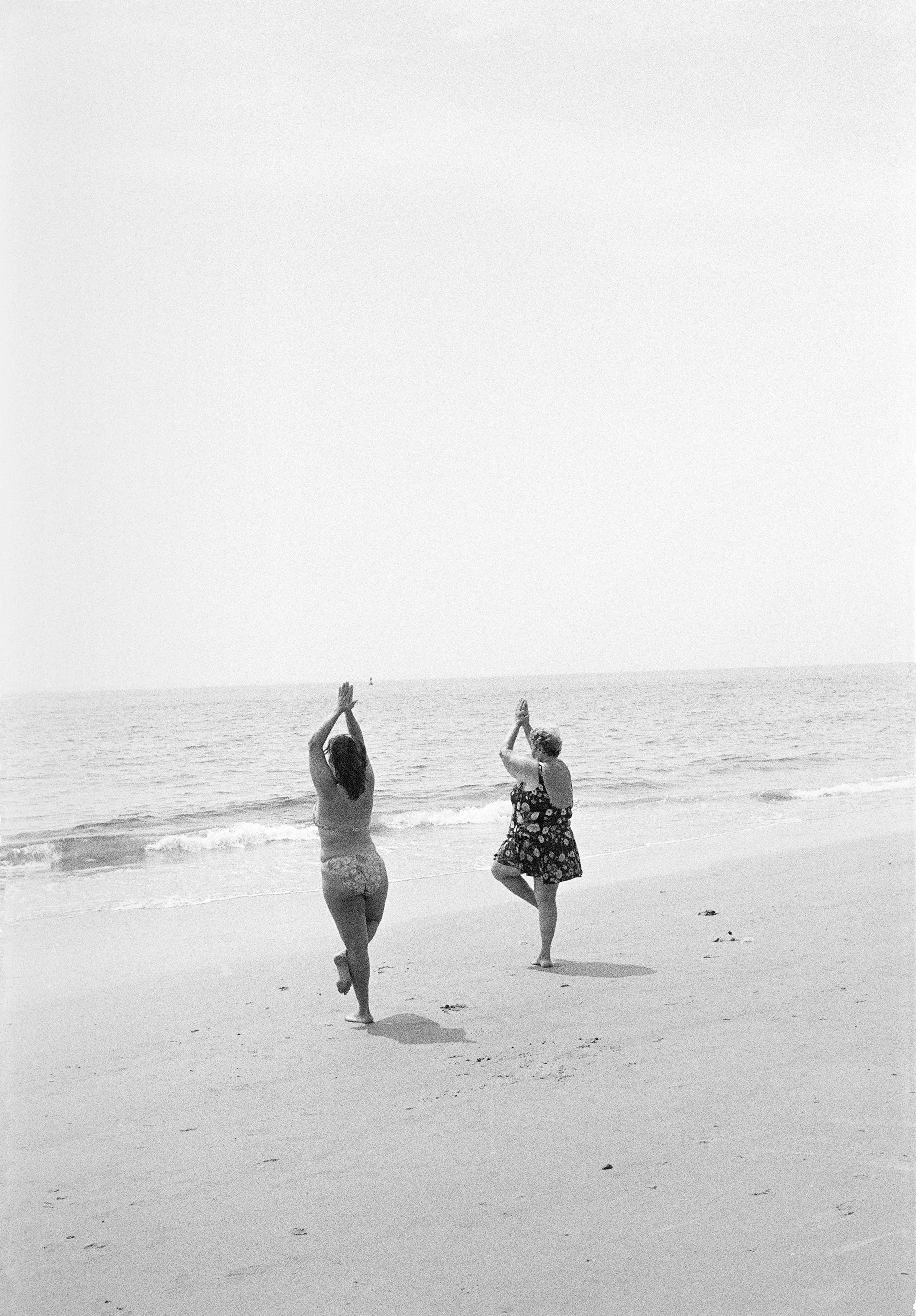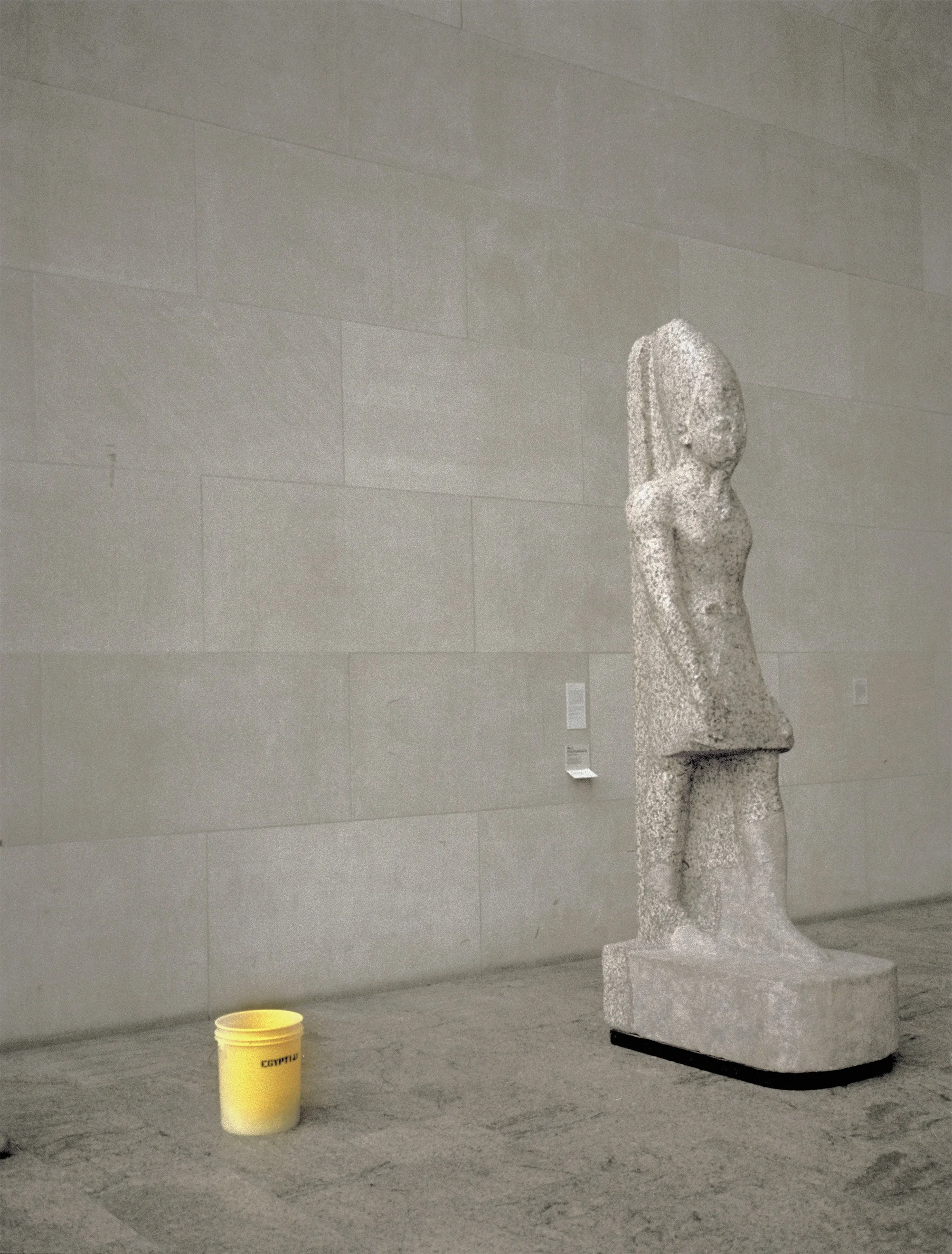This essay was produced in conjunction with the exhibition Judy Linn: LUNCH, curated by Arlene Shechet, on view at CUE Art Foundation, April 12- May 19, 2018. This text is included in the free exhibition catalogue available at CUE.
yoga, 1997
2017-2018
Archival pigment print
21.5 x 14.75 inches
Edition 3/4
Sand drifts over the photograph, dusting it lightly in grey. The grey particles float, so softly, to become the hazy sky. Two women face the ocean. A heave and a hold, their hands are raised to the near-imperceptible line of the horizon, while each woman balances on one leg in the soft, wet sand. The women exist within the vast indeterminacies of sea and sky, earth and light. They are Atlas. Their look towards the horizon can be seen to stand-in for that of the photographer, Judy Linn. And, as a projection of Linn, the scrutiny of the unknown is innate to the act of creation. Linn’s photograph echoes the early seascapes of Gustave Le Gray. Le Gray combined the sea and sky in his seascapes from separate exposures, with earth, sea, sky, and light bound to the human body through photography. Then, photography could not yet capture the sky and the sea together – the light that was needed to see the earth obliterated details of the sky. Similarly, Linn as a photographer positions herself as a locus—a fixed position from which to create photographs from the indeterminate. This act of exploration is the pulse of the photographs represented in this exhibition. It calls to the viewer to accept uncertainty and to experience the possibility there.
The capturing or framing of the indefinite reveals the inherent contradictions within such seeming infinites as sea or sky, earth or light. Judy Linn’s photographs play with the paradoxes of light. Light is the material funneled through the camera’s aperture to make images. Light illuminates hard to see details, the hidden and latent. Like the car lights shining through the haze in a smoky photograph, the light draws our eye and sharpens our focus. Light also obfuscates: a bleaching pane of light, originating out of the photograph’s frame, covers the back window of a car. Light washes out the color and texture of the car’s trunk and places another, reflected image of gauzy building tops, over the trunk’s itchy carpet. Blinding light plays over the surface of a red-brick apartment building. Chips of reflected white light repeat on the window sills otherwise ensconced in the shadows. Hit with raking light on one side of the building, the windows (with white shades pulled down to shield the rooms from the sun) become orbs.
Linn explores how the light we perceive can exist in a liminal space between discovery and destruction. It is in this space that the texture of light and the texture of time connect. William Henry Fox Talbot writes in the second fascicle in The Pencil of Nature (1844): “The sun is just quitting the range of buildings adorned with columns: its façade is already in the shade, but a single shutter standing open projects far enough forward to catch a gleam of sunshine.” Linn’s window sills and Talbot’s shutter are accidental gnomons casting the shadow of time on the world.
Linn began photographing in one of the medium’s most experimental and optimistic eras. Photography blossomed with possibility in New York City during the 1970s. Art was exuberant then, but photography, in particular, seemed unencumbered and widely exhibited for the first time in its rapidly aging life. Unlike previous generations, Linn and her fellow artists of that era consumed a vast, soon-to-be global, glut of images. In America’s post-war period, images became ubiquitous. Linn embeds images—paintings, frescoes, sculptures, brands, television screens, reflections—within her photographs. A painted portrait is decapitated by the wooden canopy of a fireplace, fringed in white cotton. The white cloth, however, overspills its banks into the painting, where it joins another painted white cloth on the figure’s clothes. The compression of the painted cloth and the actual cloth posits a conception of the world where the real is the same as the reproduced.
Linn describes the photograph as “flattening time,” when “sometimes things get better and sometimes they get worse.” When flat lining time, the asynchronous becomes fixed, and time is negated as a criterium of value. As a result, within the frame of the photograph things exist equally: the picture of a baby and a real baby are equivalent. Playing on this interchangeability, a wad of tape is carelessly slapped onto the image of a baby’s smiling, picture-cute face. The baby is oblivious. Linn has not disguised that this is a photograph, of an image, of a baby, on a cardboard box. In fact, the box is predominant in the photograph. It awkwardly and seemingly haphazardly sits in the front of the image, with the flaps and corners jutting open, in, and out of the frame. Still, the defaced baby is viscerally disconcerting. The photograph transmutes the baby’s image. The baby feels real again.
dendur, 2001
2017-2018
Archival pigment print
21 x 16 inches
Edition 1/3
A photograph of an Ancient Egyptian statue with a yellow bucket proves this sameness with wonderful humor. The pocked grey stone of the statue, the mottled grey stone of the floor, and the pale grey stone of the wall form a material utopia—the statue’s stone as valuable as the floor and the wall. The yellow plastic bucket, at first, seems to trespass into this space, introducing color and kitsch. Despite the few thousand years between the making of the statue and the bucket, the stability of the bucket’s design and use points to a different type of longevity. The bucket will never turn to dust. Where the statue is relegated to the museum, the bucket still functions. The democratization of these components proposes equality. As Linn says, “A nice make-believe world.”
Hers is a flat, edged world—an archaic conception of the universe—where time is stable and unvarying. The discovery that the earth was round brought with it the assumption that all could be known. Linn is more interested in what she “doesn’t know, eternally doesn’t know, really doesn’t know.” The edge of the earth. Creating is a way of “controlling the uncontrollable.” Uncertainty and unknowability are reasons to create. To know there is a purpose, that there is meaning, to put meaning on to something, to predefine meaning, is the antithesis of the creative process for Linn. In the stead of these overthought ambitions are the modest and straightforward aspirations of discovery and imagination: to see what the world looks like in a photograph.
---
This essay was written as part of the Art Critic Mentoring Program, a partnership between AICA-USA (US section of International Association of Art Critics) and CUE, which pairs emerging writers with AICA-USA mentors to produce original essays on a specific exhibiting artist. Please visit aicausa.org for more information on AICA-USA, or cueartfoundation.org to learn how to participate in this program. Any quotes are from interviews with the author unless otherwise specified. No part of this essay may be reproduced without prior consent from the author. Lilly Wei is AICA’s Coordinator for the program this season.
Alexandra Nicolaides is based in New York. She received her BA in Art History from Wellesley College, a MA in Art History from University College London, and an MFA in Art Criticism and Writing from the School of Visual Arts. For over a decade, she has worked as an art consultant for international clients. Currently, she is a Ph.D. student in the Art History, Criticism, and Theory department at Stony Brook University.
Mentor Charles Desmarais is the art critic for the San Francisco Chronicle. He received the Rabkin Prize for Visual Arts Journalism in 2017, and an Art Critic’s Fellowship from the National Endowment for the Arts in 1979. He spent the years between as a leader of art institutions, including the San Francisco Art Institute; Brooklyn Museum; Contemporary Arts Center, Cincinnati; Laguna Art Museum; and California Museum of Photography, UC Riverside.


